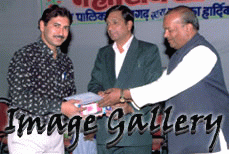| Pratapgarh is a new
district of Rajasthan near Chittorgarh & Udaipur
is the only place where Thewa art jewellery is manufactured.
The Thewa art originated here about 300 years ago.
History tells us that Nathu Lal Sonewal was the
first goldsmith who initiated this style in 1707.
It soon caught the fancy of kings and princes and
Maharaja Sumant Singh patronized this art in 1765
and granted a jagir to the family of Nathu Lal Sonewal
and conferred the title of Rajsoni on him. The family
of Nathu Lal has monopolised this technique ever
since. This craft flourished especially during the
Victorian times when a number of pieces set in gold
were sold to British women who lived here or visited
India. These pieces were taken to Europe as souvenirs.
Somehow they found their way to the British antique
market and the work was recognized by European jewellary
historians for its distinction. Some pieces about
250 years old can still be seen in the collection
of Queen Elizabeth. |
| |
| The family of Nathu
Lal jealously guarded the secret of manufacturing
thewa jewellery. The preserved the secret and did
not let it leak even to their daughters and son-in-laws.
They did not reveal the detailed technique of thewa
art even to researchers, hence inaccuracy in their
enamel, but these are absolutely meaningless terms. |
| |
| In the last century
Thewa unit makers prepared elaborate settings in
gold wire in the Canetille style, so called after
a contemporary European style. |
| |
|
To encourage this exquisite and
unique art form the Government of India issued a
postage stamp in the year 2004. |
| To add to its laurels the art
also won nine National Awards since 1966. Thewa
jewellery has been appreciated around the world
for the fine work. |
| |
| The amount of work,
time and skill that goes into handcrafting each
marvelous piece of jewellery accounts for a major
part of its Price. |
| |
| The Patterned metal
sheet is pure 23 karat gold. To creat the pierced
work design, several blank foil sheets somewhat
longer than the final result are fixed side by side
one after the other on a working surface-a board
covered with a layer of lac. The Lac is warmed and
the metal is pressed lightly onto it. |
| |
| Traditional design
subjects are carefully drwan on the gold surface
with a pointed steel scriber. The designs commonly
used can be divided into two main groups-mythological
or religious and secular. Popular subjects among
the former are Srinathji, a form of Krishna installed
at Nathdwara and Radha-Krishna. Ram parivar, Hanuman,
Mahadev and the mother goddess are also favourited
motifs. The latter include shikargah, a hunting
scene depicting animals in jungle foliage, water
streams with domestic animals and flowers and birds,
etc. |
| |
| After drwaing the
design, pockets within the subject outlines are
created with gravers and fine chisels designed by
the artisans themselves. The entire background of
the design is pierced and through these openings
the coloured glass is seen in th result. |
| |
| Besides jewellery
pieces non-jewellery thewa decorated objects include
trays, plate, photo frame, wall clock, ashtray,
heart shaped pandents, neckless set, bracelet, earrings,
tops, bangels, tie-pin, saree-pin (brouch), button-set,
betel-nut containers, rose water sprinklers, cigarette
boxes, card boxes, flower vases, cuff-links and
perfume bottle. |
| |
| The thewa technique
is no longer a family secret. Shri Vishnu Lal Soni,
not only mastered this art on his own but also won
national and international recognition for his excellent
workmanship. |





